
Simple and Ordinary Kriging#
Michael J. Pyrcz, Professor, The University of Texas at Austin
Twitter | GitHub | Website | GoogleScholar | Book | YouTube | Applied Geostats in Python e-book | LinkedIn
Chapter of e-book “Applied Geostatistics in Python: a Hands-on Guide with GeostatsPy”.
Cite this e-Book as:
Pyrcz, M.J., 2024, Applied Geostatistics in Python: a Hands-on Guide with GeostatsPy [e-book]. Zenodo. doi:10.5281/zenodo.15169133
The workflows in this book and more are available here:
Cite the GeostatsPyDemos GitHub Repository as:
Pyrcz, M.J., 2024, GeostatsPyDemos: GeostatsPy Python Package for Spatial Data Analytics and Geostatistics Demonstration Workflows Repository (0.0.1) [Software]. Zenodo. doi:10.5281/zenodo.12667036. GitHub Repository: GeostatsGuy/GeostatsPyDemos
By Michael J. Pyrcz
© Copyright 2024.
This chapter is a tutorial for / demonstration of Spatial Estimation with Kriging with GeostatsPy.
specifically we use kriging to make estimates on a grid to display as a map.
YouTube Lecture: check out my lectures on:
For convenience here’s a summary of the salient points.
Kriging is the geostatistical workhorse for:
Prediction away from wells, e.g. pre-sample assessments, interpolation and extrapolation.
Spatial cross validation.
Spatial uncertainty modeling.
First let’s explain the concept of spatial estimation.
Spatial Estimation#
Consider the case of making an estimate at some unsampled location, \(𝑧(\bf{u}_0)\), where \(z\) is the property of interest (e.g. porosity etc.) and \(𝐮_0\) is a location vector describing the unsampled location.
How would you do this given data, \(𝑧(\bf{𝐮}_1)\), \(𝑧(\bf{𝐮}_2)\), and \(𝑧(\bf{𝐮}_3)\)?
It would be natural to use a set of linear weights to formulate the estimator given the available data.
We could add an unbiasedness constraint to impose the sum of the weights equal to one. What we will do is assign the remainder of the weight (one minus the sum of weights) to the global average; therefore, if we have no informative data we will estimate with the global average of the property of interest.
We will make a stationarity assumption, so let’s assume that we are working with residuals, \(y\).
If we substitute this form into our estimator the estimator simplifies, since the mean of the residual is zero.
while satisfying the unbiasedness constraint.
The simple kriging weights are calculated by solving a linear system of equations,
that may be represented with matrix notation as,
This system may be derived by substituting the equation for kriging estimates into the equation for estimation variance, and then setting the partial derivative with respect to the weights to zero.
we are optimizing the weights to minimize the estimation variance
Kriging#
Now the next question is what weights should we use?
We could use equal weighting, \(\lambda = \frac{1}{n}\), and the estimator would be the average of the local data applied for the spatial estimate. This would not be very informative.
We could assign weights considering the spatial context of the data and the estimate:
spatial continuity as quantified by the variogram (and covariance function)
redundancy the degree of spatial continuity between all of the available data with themselves
closeness the degree of spatial continuity between the available data and the estimation location
The kriging approach accomplishes this, calculating the best linear unbiased weights for the local data to estimate at the unknown location. The derivation of the kriging system and the resulting linear set of equations is available in the lecture notes. Furthermore kriging provides a measure of the accuracy of the estimate! This is the kriging estimation variance (sometimes just called the kriging variance).
What is ‘best’ about this estimate? Kriging estimates are best in that they minimize the above estimation variance.
Simple vs. Ordinary Kriging#
The difference between simple and ordinary kriging is related to the assumption of stationarity for the distribution mean:
simple kriging - assumes a known global stationary mean. The global mean is a user supplied input.
ordinary kriging - relaxes the assumption of stationarity in the mean, instead the mean is calculated locally by the kriging system. This is accomplished with the additional constraint that the sum of the weights is equal to 1.0.
To understand how this is accomplished, here are some more details about simple and ordinary kriging,
Simple Kriging - global stationary mean is an input provided by the user, i.e., the mean is assumed to be stationary.
for the kriging estimate, one minus the sum of the data weights is applied to the global stationary mean.
at data locations all weight is applied to the collocated datum, and beyond the variogram range from all data all weight is applied to the global mean.
the simple kriging weights, \(\lambda_1, \lambda_2, \dots, \lambda_n\), are calculated by solving this system of equations represented in matrix notation as,
Ordinary Kriging - local nonstationary mean calculated by the kriging system. The global mean is not an input, instead the local nonstationary mean is calculated by ordinary kriging. This relaxes the assumption of a stationary mean.
this is accomplished with the addition of a data kriging weights must sum to one constraint in the kriging system,
if the weights must sum to one, this removes the right hand unbiasedness constraint from the kriging estimate with the global mean,
at data locations all weight is applied to the collocated datum, and beyond the variogram range from all data, all weight is applied to the local mean calculated from local data
the ordinary kriging weights, \(\lambda_1, \lambda_2, \dots, \lambda_n\), are calculated by solving this system of equations, the simple kriging system with the added constraint that the weight sum to 1.0 represented in matrix notation as,
where \(\mu\) is a Langrange multiplier that is added to complete the system of equations, but is typically ignored.
Properties of Kriging#
Here are some important properties of kriging:
Exact interpolator - kriging estimates with the data values at the data locations
Kriging variance can be calculated before getting the sample information, as the kriging estimation variance is not dependent on the values of the data nor the kriging estimate, i.e. the kriging estimator is homoscedastic.
Spatial context - kriging takes into account, furthermore to the statements on spatial continuity, closeness and redundancy we can state that kriging accounts for the configuration of the data and structural continuity of the variable being estimated.
Scale - kriging may be generalized to account for the support volume of the data and estimate. We will cover this later.
Multivariate - kriging may be generalized to account for multiple secondary data in the spatial estimate with the cokriging system. We will cover this later.
Smoothing effect of kriging can be forecast. We will use this to build stochastic simulations later.
Load the Required Libraries#
The following code loads the required libraries.
import geostatspy.GSLIB as GSLIB # GSLIB utilities, visualization and wrapper
import geostatspy.geostats as geostats # GSLIB methods convert to Python
import geostatspy
print('GeostatsPy version: ' + str(geostatspy.__version__))
GeostatsPy version: 0.0.78
We will also need some standard packages. These should have been installed with Anaconda 3.
import os # set working directory, run executables
from tqdm import tqdm # suppress the status bar
from functools import partialmethod
tqdm.__init__ = partialmethod(tqdm.__init__, disable=True)
ignore_warnings = True # ignore warnings?
import numpy as np # ndarrays for gridded data
import pandas as pd # DataFrames for tabular data
import matplotlib.pyplot as plt # for plotting
plt.rc('axes', axisbelow=True) # plot all grids below the plot elements
if ignore_warnings == True:
import warnings
warnings.filterwarnings('ignore')
cmap = plt.cm.inferno # color map
If you get a package import error, you may have to first install some of these packages. This can usually be accomplished by opening up a command window on Windows and then typing ‘python -m pip install [package-name]’. More assistance is available with the respective package docs.
Set the Working Directory#
I always like to do this so I don’t lose files and to simplify subsequent read and writes (avoid including the full address each time).
#os.chdir("d:/PGE383") # set the working directory
Loading Tabular Data#
Here’s the command to load our comma delimited data file in to a Pandas’ DataFrame object.
note the “fraction_data” variable is an option to random take part of the data (i.e., 1.0 is all data).
this is not standard part of spatial estimation, but fewer data is easier to visualize given our grid size (we want multiple cells between the data to see the behavior away from data)
note, I often remove unnecessary data table columns. This clarifies workflows and reduces the chance of blunders, e.g., using the wrong column!
fraction_data = 0.2 # extract a fraction of data for demonstration / faster runs, set to 1.0 for homework
df = pd.read_csv("https://raw.githubusercontent.com/GeostatsGuy/GeoDataSets/master/sample_data_MV_biased.csv") # load the data from Dr. Pyrcz's GitHub repository
if fraction_data < 1.0:
df = df.sample(frac = fraction_data,replace = False,random_state = 73073) # random sample from the dataset
df = df.reset_index() # reorder the data index
df = df.iloc[:,2:7] # remove the unneeded features, columns
df['LogPerm'] = np.log(df['Perm'].values) # apply the log transform to remove skew from permeability
df.head() # preview the DataFrame
| X | Y | Facies | Porosity | Perm | LogPerm | |
|---|---|---|---|---|---|---|
| 0 | 280.0 | 409.0 | 1.0 | 0.136716 | 17.126888 | 2.840650 |
| 1 | 230.0 | 749.0 | 1.0 | 0.204587 | 1665.384124 | 7.417811 |
| 2 | 300.0 | 500.0 | 1.0 | 0.159891 | 105.797436 | 4.661526 |
| 3 | 620.0 | 389.0 | 0.0 | 0.100296 | 7.578784 | 2.025353 |
| 4 | 370.0 | 689.0 | 1.0 | 0.142434 | 218.419949 | 5.386420 |
Summary Statistics#
Let’s look at summary statistics for all facies combined:
df.describe().transpose() # summary table of all facies combined DataFrame statistics
| count | mean | std | min | 25% | 50% | 75% | max | |
|---|---|---|---|---|---|---|---|---|
| X | 74.0 | 471.891892 | 282.603724 | 0.000000 | 232.500000 | 405.000000 | 765.000000 | 990.000000 |
| Y | 74.0 | 489.932432 | 291.512933 | 9.000000 | 224.000000 | 484.500000 | 729.000000 | 999.000000 |
| Facies | 74.0 | 0.594595 | 0.494322 | 0.000000 | 0.000000 | 1.000000 | 1.000000 | 1.000000 |
| Porosity | 74.0 | 0.125834 | 0.031093 | 0.062169 | 0.102895 | 0.126264 | 0.148840 | 0.204587 |
| Perm | 74.0 | 73.040451 | 214.164084 | 0.300430 | 2.081215 | 10.385010 | 50.841029 | 1665.384124 |
| LogPerm | 74.0 | 2.358329 | 2.086617 | -1.202542 | 0.731083 | 2.339396 | 3.928694 | 7.417811 |
Let’s also look at the distributions, specifically the cumulative distribution functions (CDFs).
plt.subplot(121) # plot original sand and shale porosity histograms
plt.hist(df['Porosity'], facecolor='darkorange',bins=np.linspace(0.0,0.25,1000),histtype="stepfilled",alpha=0.8,density=True,cumulative=True,edgecolor='black',label='Original')
plt.xlim([0.05,0.25]); plt.ylim([0,1.0])
plt.xlabel('Porosity (fraction)'); plt.ylabel('Frequency'); plt.title('Porosity')
plt.legend(loc='upper left')
plt.grid(True)
plt.subplot(122) # plot nscore transformed sand and shale histograms
plt.hist(df['Perm'], facecolor='darkorange',bins=np.linspace(0.0,1000.0,100000),histtype="stepfilled",alpha=0.8,density=True,cumulative=True,edgecolor='black',label='Original')
plt.xlim([0.0,1000.0]); plt.ylim([0,1.0])
plt.xlabel('Permeability (mD)'); plt.ylabel('Frequency'); plt.title('Permeability')
plt.legend(loc='upper left')
plt.grid(True)
plt.subplots_adjust(left=0.0, bottom=0.0, right=2.0, top=1.2, wspace=0.2, hspace=0.2)
plt.show()
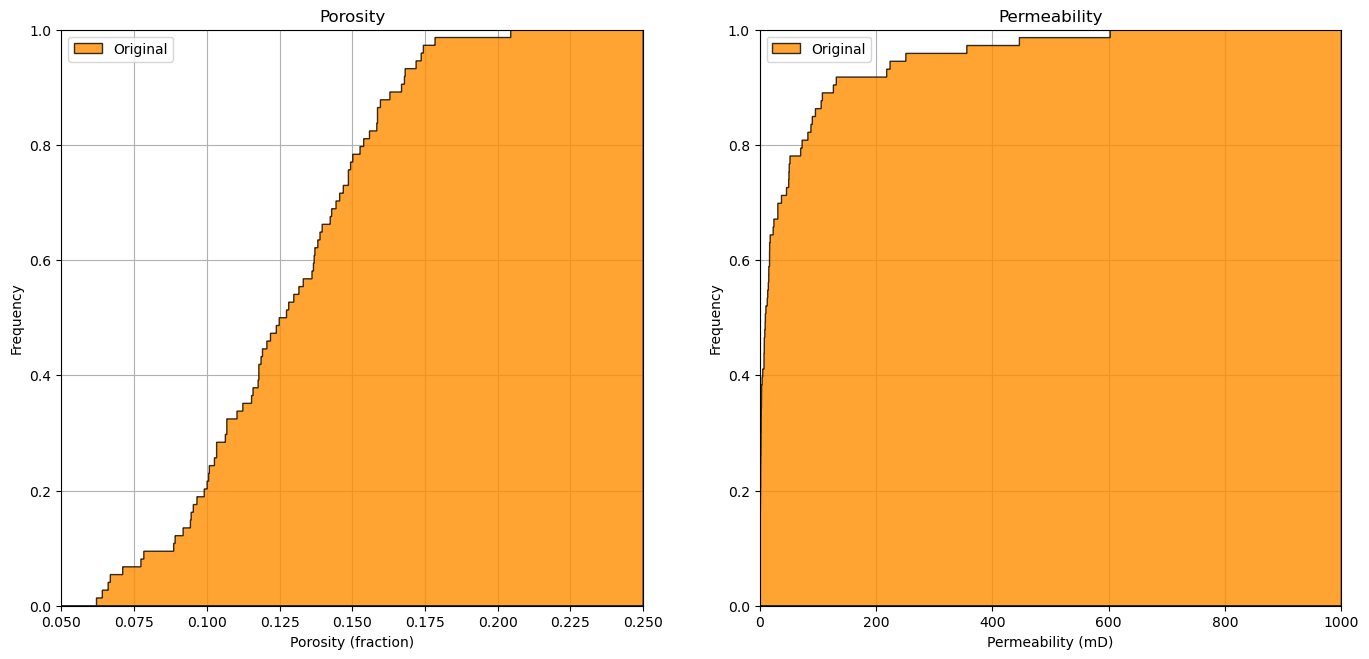
We observe from the CDFs that the porosity distribution is ‘Gaussian-like’ in shape, while the permeability distribution is ‘lognormal-like’. They both look well behaved.
Calculating the Representative Mean with Declustering#
For brevity we omit data inference from this workflow:
declustering for the representative distribution and statistics
variogram calculation and modeling spatial continuity
Instead we:
assume the declustered means for the porosity and permeability to apply with simple kriging.
change the variogram models to observe the impact on simple kriging.
Specify the Grid#
Let’s specify a reasonable grid to the estimation map.
we balance detail and computation time. Note kriging computation complexity scales \(O(n_{cell})\)
so if we half the cell size we have 4 times more grid cells in 2D, 4 times the runtime
xmin = 0.0; xmax = 1000.0 # range of x values
ymin = 0.0; ymax = 1000.0 # range of y values
xsiz = 10; ysiz = 10 # cell size
nx = 100; ny = 100 # number of cells
xmn = 5; ymn = 5 # grid origin, location center of lower left cell
pormin = 0.05; pormax = 0.22 # set feature min and max for colorbars
permmin = 0.0; permmax = 700.0
Location Maps#
Let’s plot the location maps of porosity and permeability for all facies. We will also include a cross plot of permeability vs. porosity colored by facies to aid with comparison in spatial features between the porosity and permeability data.
plt.subplot(121)
GSLIB.locmap_st(df,'X','Y','Porosity',0,1000,0,1000,pormin,pormax,'Porosity - All Facies','X (m)','Y (m)','Nscore Porosity',cmap)
plt.subplot(122)
GSLIB.locmap_st(df,'X','Y','Perm',0,1000,0,1000,permmin,permmax,'Permeability - All Facies','X (m)','Y (m)','Nscore Permeability',cmap)
plt.subplots_adjust(left=0.0, bottom=0.0, right=2.0, top=1.0, wspace=0.2, hspace=0.2); plt.show()
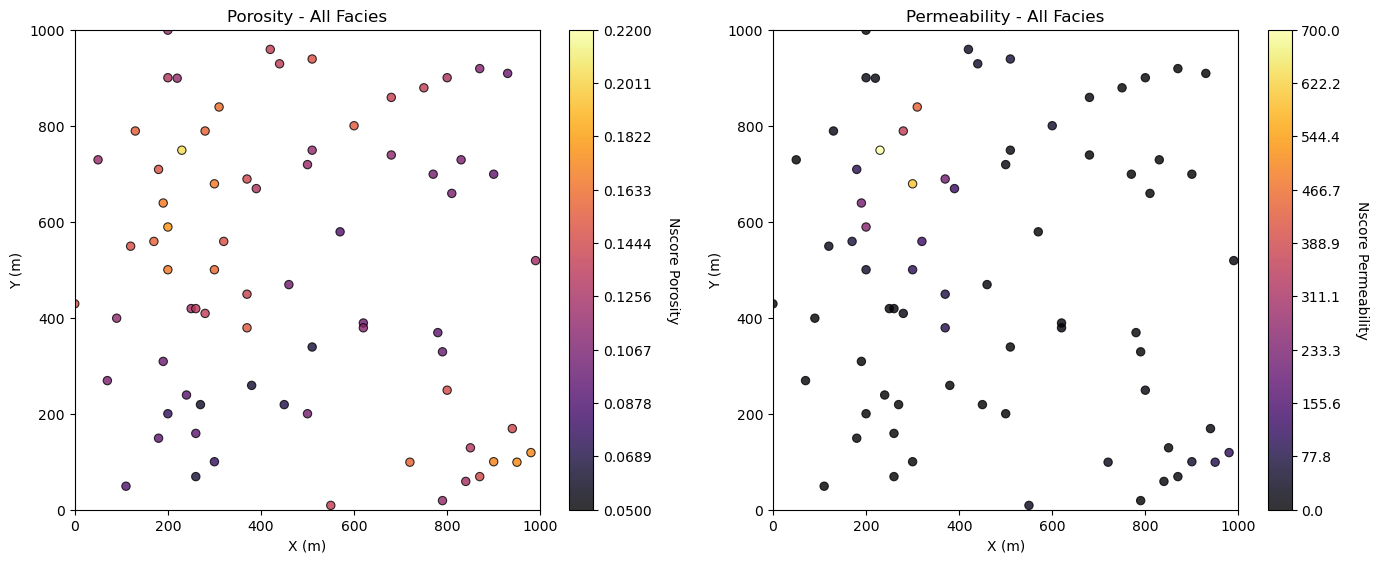
Simple Kriging for Estimation Maps#
Now let’s try some kriging with the continuous properties. For this workflow we will demonstrate a cookie-cutter approach. The steps are:
model the facies, sand and shale, probabilities with indicator kriging
model the porosity for sand and shale separately and exhaustively, i.e. at all locations in the model
model the permeability for sand and shale separately and exhaustively, i.e. at all locations in the model
assign sand and shale locations based on the probabilities from step 1
combine the porosity and permeability from sand and shale regions together
Limitations of this Workflow:
kriging is too smooth, the spatial continuity is too high
kriging does not reproduce the continuous property distributions
we are not accounting for the correlation between porosity and permeability
We will correct these issues when we perform simulation later.
Simple Kriging Estimation Map of Porosity#
Let’s specify the variogram model, global stationary mean and variance, and kriging parameters.
%%capture --no-display
por_vrange_maj = 250; por_vrange_min = 100 # variogram ranges
por_vazi = 150.0 # variogram major direction
por_vrel_nugget = 0.0 # variogram nugget effect
por_skmean = np.average(df['Porosity'].values) # assume global mean is the mean of the sample
por_sill = np.var(df['Porosity'].values) # assume sill is variance of the sample
por_vario = GSLIB.make_variogram(nug=por_vrel_nugget*por_sill,nst=1,it1=1,cc1=(1.0-por_vrel_nugget)*por_sill,
azi1=por_vazi,hmaj1=por_vrange_maj,hmin1=por_vrange_min) # porosity variogram
ktype = 0 # kriging type, 0 - simple, 1 - ordinary
radius = 600 # search radius for neighbouring data
nxdis = 1; nydis = 1 # number of grid discretizations for block kriging
ndmin = 0; ndmax = 10 # minimum and maximum data for an estimate
Now let’s pass this to kriging to make our porosity kriging estimate map.
por_kmap, por_vmap = geostats.kb2d(df,'X','Y','Porosity',pormin,pormax,nx,xmn,xsiz,ny,ymn,ysiz,nxdis,nydis,
ndmin,ndmax,radius,ktype,por_skmean,por_vario)
plt.subplot(121)
GSLIB.locpix_st(por_kmap,xmin,xmax,ymin,ymax,xsiz,pormin,pormax,df,'X','Y','Porosity','Simple Kriging Estimates and Data','X(m)','Y(m)','Porosity (%)',cmap)
plt.subplot(122)
GSLIB.pixelplt_st(por_vmap,xmin,xmax,ymin,ymax,xsiz,0.0,por_sill,'Kriging Variance','X(m)','Y(m)',r'Porosity ($\%^2$)',cmap)
plt.subplots_adjust(left=0.0, bottom=0.0, right=2.0, top=1.0, wspace=0.2, hspace=0.2); plt.show()
Estimated 10000 blocks
average 0.12433154498291114 variance 0.00036429504237079496
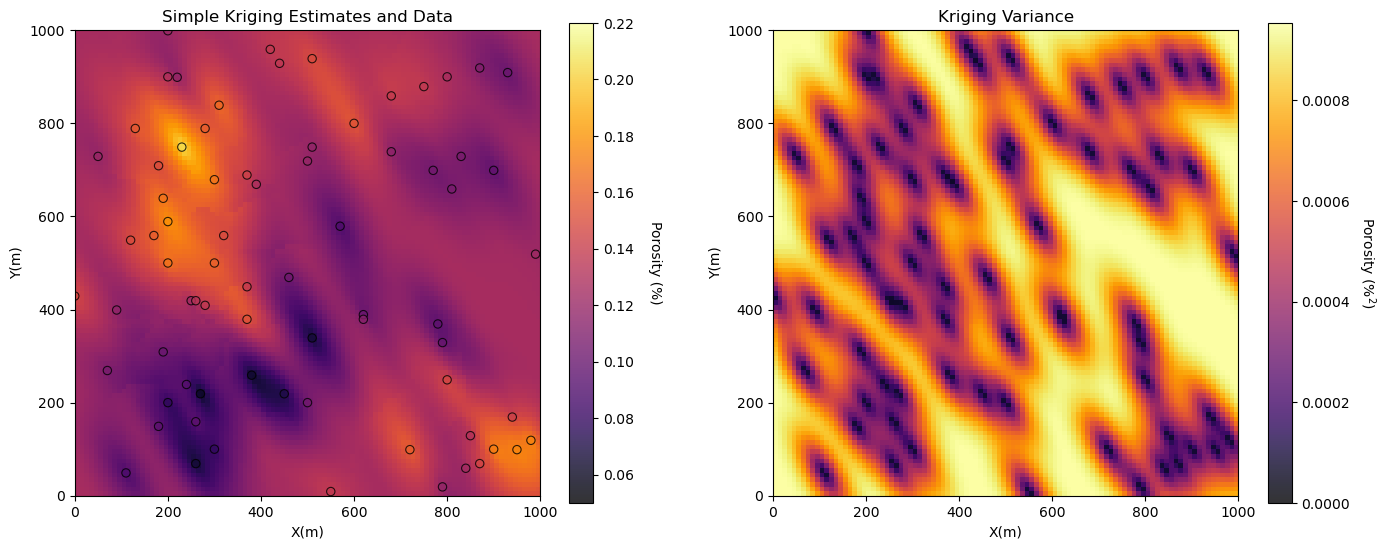
Some observations for simple kriging:
Smooth Estimates - see the smooth kriging estimates
Estimate the Global Mean - estimated values at distance greater than the variogram range from any data approach the global mean.
Exactitude - estimate the data values with 0.0 estimation variance at data locations.
Variogram Model - see the kriging estimation and variance map and observe the impact of variogram range and potential anisotropy.
Search Artifacts - you may see artifacts, arcs or rays with sharp changes in estimates or estimation variance.
Simple Kriging Estimation Map of Permeability#
Now let’s calculate the kriging estimation map for permeability
note, due to the strong positive skew of permeability and the kriging screening effect, permeability estimates may be very small or even negative. We truncate the map to clean this up
we will apply the log transformation to improve the visualization. We could also plot in log scale, but this is not very convenient with MatPlotLib.
Note, there is the potential issues when modeling log transformed permeability.
this includes invalidating model assumptions, such as homoscedastic error, and also reduced interpretability
so we only apply log transform for visualization, the actual model is in the original permeability feature
Let’s specify the variogram model, global stationary mean and variance, and kriging parameters.
%%capture --no-display
perm_vrange_maj = 250; perm_vrange_min = 100 # variogram ranges
perm_vazi = 150.0 # variogram major direction
perm_vrel_nugget = 0.0 # variogram nugget effect
perm_skmean = np.average(df['Perm'].values) # assume global mean is the mean of the sample
perm_sill = np.var(df['Perm'].values) # assume sill is variance of the sample
perm_vario = GSLIB.make_variogram(nug=perm_vrel_nugget*perm_sill,nst=1,it1=1,cc1=(1.0-perm_vrel_nugget)*perm_sill,
azi1=perm_vazi,hmaj1=perm_vrange_maj,hmin1=perm_vrange_min) # permeability variogram
ktype = 0 # kriging type, 0 - simple, 1 - ordinary
radius = 600 # search radius for neighbouring data
nxdis = 1; nydis = 1 # number of grid discretizations for block kriging
ndmin = 0; ndmax = 10 # minimum and maximum data for an estimate
Now let’s pass this to kriging to make our permeability kriging estimate map.
%%capture --no-display
perm_kmap, perm_vmap = geostats.kb2d(df,'X','Y','Perm',permmin,permmax,nx,xmn,xsiz,ny,ymn,ysiz,nxdis,nydis,
ndmin,ndmax,radius,ktype,perm_skmean,perm_vario)
perm_kmap[perm_kmap < 0.0001] = 0.0001 # remove small and negative values due to strong positive skew and negative kriging weights
plt.subplot(221)
GSLIB.locpix_st(perm_kmap,xmin,xmax,ymin,ymax,xsiz,permmin,permmax,df,'X','Y','Perm','Simple Kriging Estimates and Data','X(m)','Y(m)','Permeability (mD)',cmap)
logperm_kmap = np.log(perm_kmap)
plt.subplot(222)
GSLIB.locpix_st(logperm_kmap,xmin,xmax,ymin,ymax,xsiz,0.0,6.0,df,'X','Y','LogPerm','Simple Kriging Log(Estimates and Data)','X(m)','Y(m)','Log Permeability (mD)',cmap)
plt.subplot(223)
GSLIB.pixelplt_st(perm_vmap,xmin,xmax,ymin,ymax,xsiz,0.0,perm_sill,'Kriging Variance','X(m)','Y(m)',r'Permeability ($mD^2$)',cmap)
plt.subplots_adjust(left=0.0, bottom=0.0, right=2.0, top=2.0, wspace=0.2, hspace=0.2); plt.show()
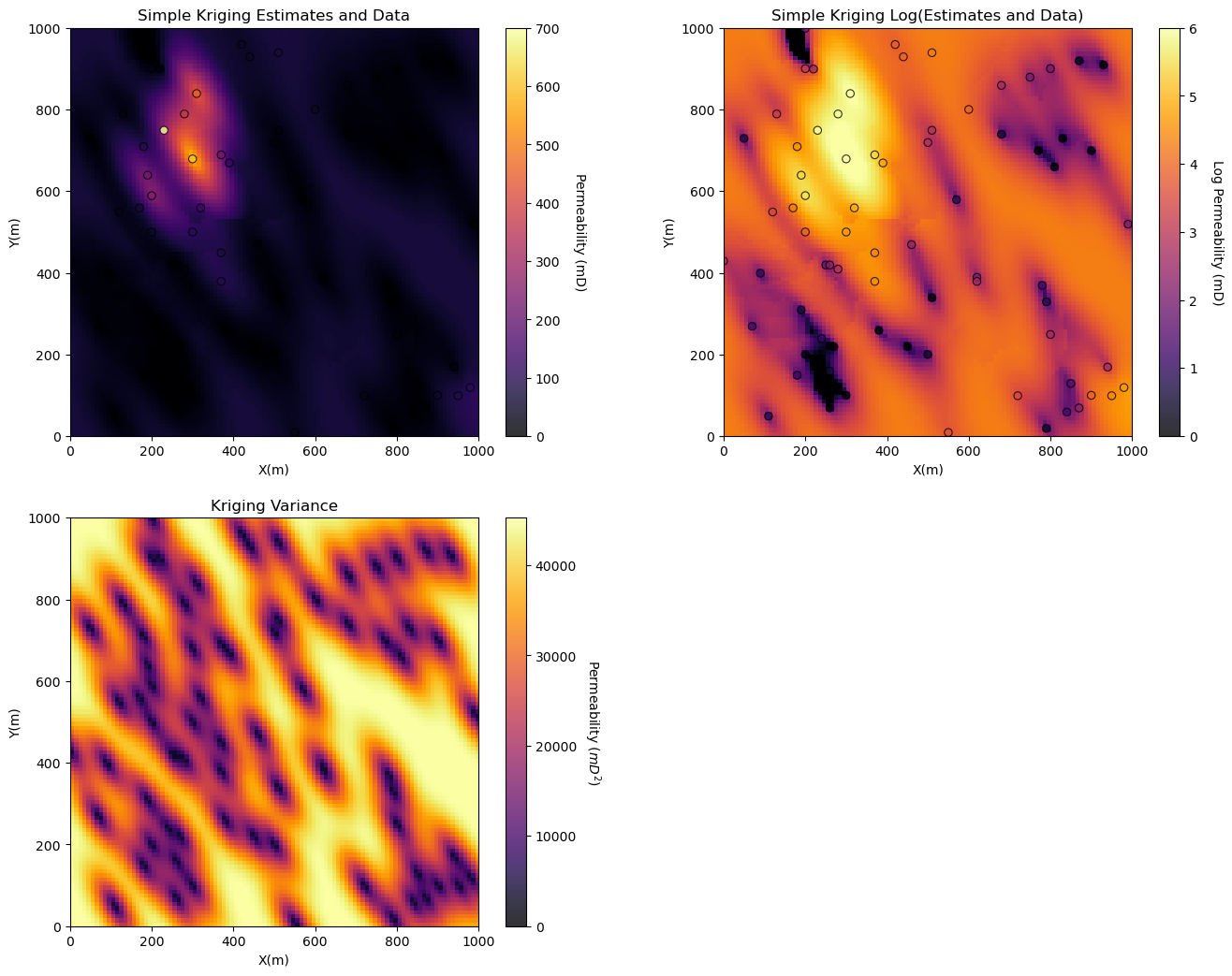
Ordinary Kriging for Estimation Maps#
Let’s try ordinary kriging and compare the results to simple kriging.
to switch to ordinary kriging set the kriging ktype to 1
we shorten the variogram model range to exaggerate the difference between simple and ordinary kriging, i.e., with estimates outside variogram range from any data
%%capture --no-display
por_vrange_maj2 = 150; por_vrange_min2 = 50 # variogram ranges
por_vazi2 = 150.0 # variogram major direction
por_vrel_nugget2 = 0.0 # variogram nugget effect
por_vario2 = GSLIB.make_variogram(nug=por_vrel_nugget2*por_sill,nst=1,it1=1,cc1=(1.0-por_vrel_nugget2)*por_sill,
azi1=por_vazi2,hmaj1=por_vrange_maj2,hmin1=por_vrange_min2) # porosity variogram
ktype = 0 # simple kriging
por_SK_kmap, por_vmap = geostats.kb2d(df,'X','Y','Porosity',pormin,pormax,nx,xmn,xsiz,ny,ymn,ysiz,nxdis,nydis,
ndmin,ndmax,radius,ktype,por_skmean,por_vario2)
ktype = 1 # ordinary kriging
por_OK_kmap, por_OK_vmap = geostats.kb2d(df,'X','Y','Porosity',pormin,pormax,nx,xmn,xsiz,ny,ymn,ysiz,nxdis,nydis,
ndmin,ndmax,radius,ktype,por_skmean,por_vario2)
plt.subplot(121)
GSLIB.locpix_st(por_SK_kmap,xmin,xmax,ymin,ymax,xsiz,pormin,pormax,df,'X','Y','Porosity','Simple Kriging Estimates and Data','X(m)','Y(m)','Porosity (%)',cmap)
plt.subplot(122)
GSLIB.locpix_st(por_OK_kmap,xmin,xmax,ymin,ymax,xsiz,pormin,pormax,df,'X','Y','Porosity','Ordinary Kriging Estimates and Data','X(m)','Y(m)','Porosity (%)',cmap)
plt.subplots_adjust(left=0.0, bottom=0.0, right=2.0, top=1.0, wspace=0.2, hspace=0.2); plt.show()
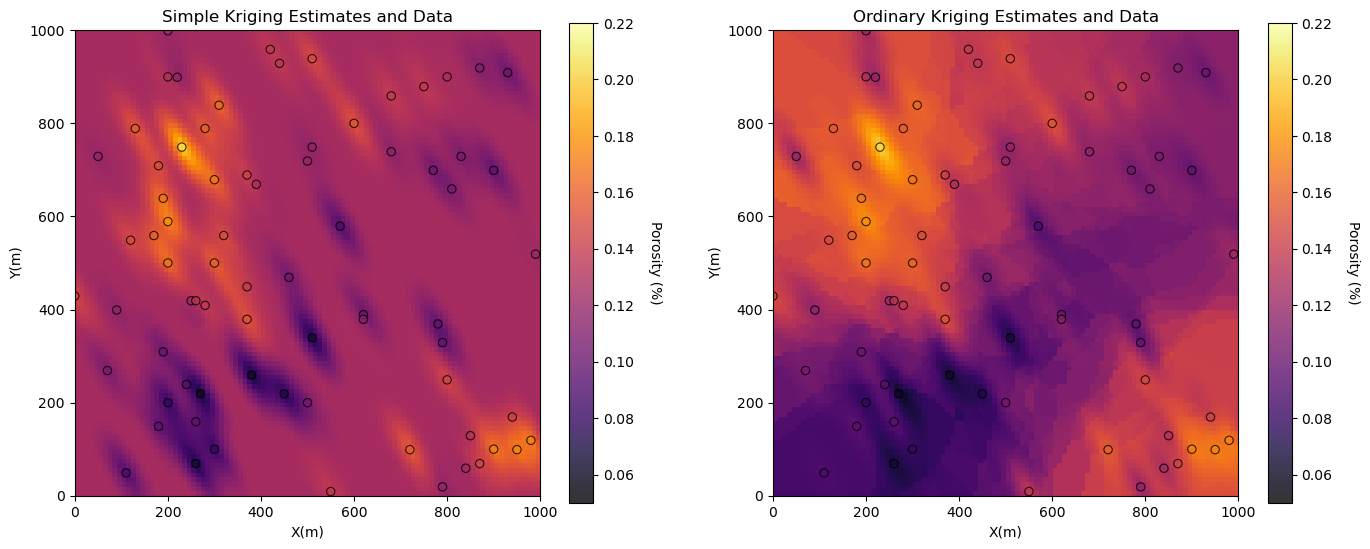
Note that simple kriging returns to the global mean away from the data while ordinary kriging estimates with the local mean away from data.
Recall that simple kriging assumes a global stationary mean while ordinary kriging estimates a local nonstationary mean.
Want to Work Together?#
I hope this content is helpful to those that want to learn more about subsurface modeling, data analytics and machine learning. Students and working professionals are welcome to participate.
Want to invite me to visit your company for training, mentoring, project review, workflow design and / or consulting? I’d be happy to drop by and work with you!
Interested in partnering, supporting my graduate student research or my Subsurface Data Analytics and Machine Learning consortium (co-PI is Professor John Foster)? My research combines data analytics, stochastic modeling and machine learning theory with practice to develop novel methods and workflows to add value. We are solving challenging subsurface problems!
I can be reached at mpyrcz@austin.utexas.edu.
I’m always happy to discuss,
Michael
Michael Pyrcz, Ph.D., P.Eng. Professor, Cockrell School of Engineering and The Jackson School of Geosciences, The University of Texas at Austin
More Resources Available at: Twitter | GitHub | Website | GoogleScholar | Geostatistics Book | YouTube | Applied Geostats in Python e-book | Applied Machine Learning in Python e-book | LinkedIn


Comments#
This was a basic demonstration of simple and ordinary kriging for spatial estimation with GeostatsPy. Much more can be done, I have other demonstrations for modeling workflows with GeostatsPy in the GitHub repository GeostatsPy_Demos.
I hope this is helpful,
Michael